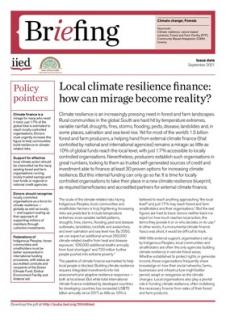
As rural communities in the global South are hard hit by temperature extremes, variable rainfall, droughts, fires, storms, flooding, pests, disease, landslides and, in some places, salination and sea level rise, climate resilience is an increasingly pressing need in forest and farm landscapes.
This briefing paper presents challenges to allocating and earmarking climate finance to building local climate resilience, and points to potential solutions. For example, the report suggests that that resilience responses are upscaled through local organizations, and that support is channelled via the many existing forest and farm organisations running locally trusted savings and loan funds or regional or national credit agencies.
The paper also outlines that for most of the world’s 1.5 billion forest and farm producers, a helping hand from external climate finance - controlled by national and international agencies - remains a mirage: as little as 10% of global funds reach the local level, with just 1.7% accessible to locally controlled organisations. Nevertheless, the paper showcases that producers establish such organizations in great numbers, looking to them as trusted self-generated sources of credit and investment able to finance at least 30 proven options for increasing climate resilience.
